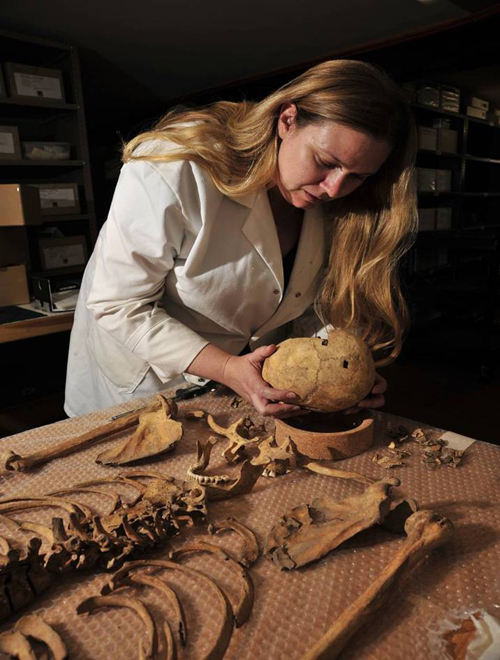“Let’s do some date nights,” the Panther of News and I have agreed. Something to add a little extra – if not romance – that certainly a bit of time away from the boring old work-home-telly-repeat routine.
So when I got an email telling me of a Historic Scotland event called Silent Witness: Trauma Tales at Stirling Castle I knew it was just the thing for us – suckers as we are for cadavers and mysteries.
In 1997 nine skeletons were discovered beneath the floor of a disused royal chapel at Stirling Castle. The bodies of eight males and one female were aged from three months to middle age and were quite likely to have come from time of the Scottish Wars of Independence (1297 – 1357).
The bodies have been examined by biological anthropologist Dr Jo Buckberry who gave a fascinating insight into what dem bones say to us today.

Here’s what I learned from our evening at the castle:
Your bones tell you how strong you were. The part where your muscle attached to your bone is bigger or smaller depending on how strong you were and how much exercise you did. Who knew? Well probably lots of people, but I didn’t.
How an as-yet-unwritten episode of Taggart must start. I know Taggart looks to be as dead as a murder victim, but if it’s ever resurrected then the opening scene could well be a talk in a Medieval Castle about some bodies that were, in all probability, brutally killed. Among the seemingly respectable audience of mild middle-aged people are some who hide a secret…
Reenactment people are a tad scary. That night the castle was also camp-ground to historic reenactment people. Their wood smoke and olden-days chatter filled the air. A couple of them joined the audience in the talk, bringing their hot drinks in hollowed-out horns rather than paper and Styrofoam. Either that or I was seeing ghosts.
Stirling Castle is breathtaking. Views from the castle in all directions are stunning. For my HIstoric Scotland membership, it’s much better than Edinburgh.
Inbreeding shows in the bones. Several of the bodies under the chapel showed signs of anomalies such as scoliosis (the same as Richard III) and lumbarisation. These aren’t impossibly rare, but the presence of some anomalies in such a small group suggests intermarriage between cousins. Likely because they were too important to get hitched to the hoi polloi.
Your teeth reveal where you’re from. I’m about to get vague on the sciency stuff, but apparently the isotopes in your teeth reveal where you were between the ages of two and six, because you will have absorbed, erm, stuff from the geology of the place you lived. Only one of the bodies at Stirling could have been brought up there and that was the woman.
The blood and brutality must have been horrific. Stone and bones are pale and clean, sterile even. However when you add flesh to the stories, you quickly imagine buckets of blood and agonisingly ragged wounds.
Bones take on the colour of the soil they’re buried in. So if the skeleton is yellowy or orange, you can blame the soil they were left in. If someone tells you where a bone is from it’s probably science, not just a weird talent.
My bones might not make a very interesting tale. Or at least I don’t think so. They might prove that that really sore stubbed toe was, in fact, broken. That I made a bit of an effort at exercise. That I was brought up in Cumbria.
That boring bones are probably a good result in the end. I sincerely hope they won’t tell of brutal wounds inflicted by hideous and cruel weapons. I’d be rather pleased if they don’t reveal malnutrition or disease. In fact, I’d settle, a long, long time from now, for having the skeleton of a very old lady.